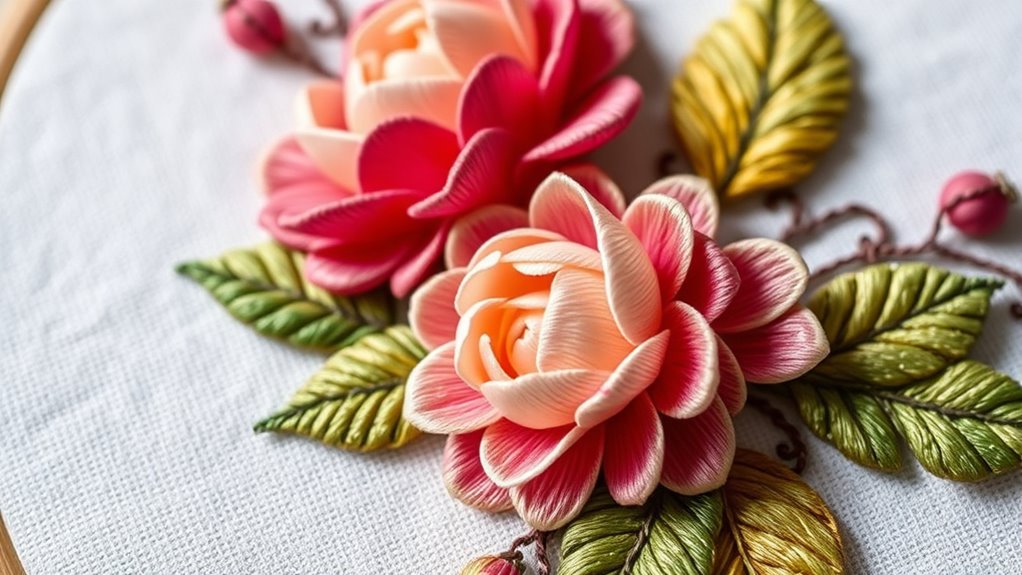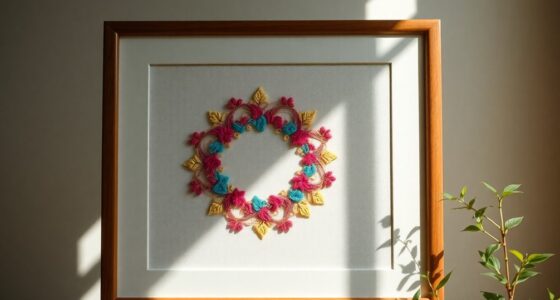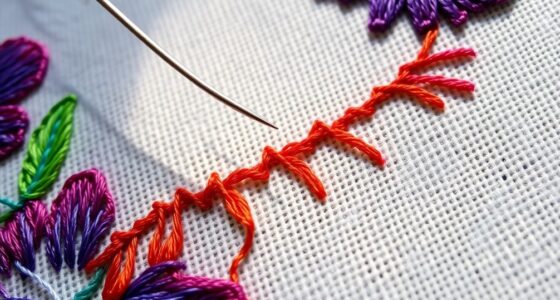Stumpwork embroidery is a stunning craft that brings designs to life by creating three-dimensional, raised effects on fabric. Using techniques like padding, wire shaping, and careful stitching, you can make figures and motifs that seem to leap off the surface. This art form dates back centuries and showcases skill, creativity, and detailed craftsmanship. If you keep exploring, you’ll uncover the fascinating skills and history behind this intricate embroidery style.
Key Takeaways
- Stumpwork embroidery creates three-dimensional, raised designs using padding, wire, and layered stitches for realistic effects.
- It originated in the Elizabethan era, showcasing craftsmanship and serving as decorative art in clothing and objects.
- Techniques include padding stitches, couching, and wire shaping to add depth and detail to embroidered motifs.
- This art form combines technical skill with artistic storytelling, reflecting cultural significance and social status.
- Learning stumpwork involves mastering various stitches and methods to produce textured, lifelike embroidered designs.

Have you ever wondered what makes stumpwork embroidery stand out among traditional needlework techniques? The answer lies in its unique ability to create three-dimensional, raised designs that seem to leap off the fabric. Unlike flat embroidery styles, stumpwork involves building up layers of stitches, padding, and sometimes even wire to craft lifelike figures, floral arrangements, and intricate motifs. This technique demands a different set of embroidery techniques, combining fine detail with a sense of depth that commands attention. Its distinctive look isn’t just a modern innovation; it carries a rich historical significance, dating back to the Elizabethan era when embroiderers sought to showcase their skill and creativity. During that period, stumpwork was often used to embellish clothing, accessories, and decorative objects for the wealthy, serving as both ornamentation and a display of wealth. Its origins are linked to the desire for more elaborate and realistic representations, pushing embroidery beyond simple surface decoration.
As you explore stumpwork embroidery, you’ll notice that mastering this technique requires a keen understanding of various embroidery techniques. For example, padding stitches are essential to give volume, while couching and attaching wire help mold shapes that hold their form. You’ll also use long and short stitches to add shading and realism, much like painting with thread. The process involves meticulous planning, as each element must be carefully positioned and secured to maintain the design’s three-dimensional effect. This complexity is part of what gives stumpwork its enduring appeal, blending craftsmanship with artistic expression. The historical significance of stumpwork isn’t just in its appearance but also in what it reveals about the social and cultural contexts of the periods it was popular. It reflects a time when embroidery was more than mere decoration—it was a display of skill, a symbol of status, and an art form that told stories.
Learning about stumpwork embroidery means embracing its historical roots while honing your embroidery techniques. It’s a craft that connects you to centuries of artisans who pushed the boundaries of needlework, transforming simple stitches into expressive, tangible art. Whether you’re creating a lifelike butterfly or a delicate floral bouquet, each piece carries a legacy of innovation and tradition. As you develop your skills, you’ll come to appreciate just how significant this form of embroidery is—not only for its visual impact but also for its role in the history of textile arts. Stumpwork invites you to combine technical precision with creative storytelling, making it a rewarding and meaningful pursuit.
Frequently Asked Questions
What Are the Best Fabrics for Stumpwork Embroidery?
You should choose fabric with a tight weave, like cotton or silk, for stumpwork embroidery. These fabrics provide a sturdy base that supports detailed stitches and enhances texture. Avoid flimsy or stretchy materials, as they can distort your work. Selecting the right fabric guarantees your 3D stitches hold well, allowing you to achieve beautiful texture enhancement and maintain the intricate details that make stumpwork embroidery so striking.
How Long Does It Typically Take to Complete a Stumpwork Piece?
It usually takes anywhere from several weeks to several months to complete a stumpwork embroidery piece, depending on its complexity and your skill level. For simpler designs, expect a shorter time commitment, maybe a few weeks. More detailed or intricate projects require patience and consistent effort, often stretching over months. Your progress depends on how much time you dedicate each session and how complex the design is, so plan accordingly.
What Tools Are Essential for Beginners in Stumpwork?
Did you know that mastering just five embroidery tools can greatly boost your confidence as a beginner? For stumpwork, essential embroidery tools include fine embroidery needles, sharp scissors, and a variety of threads like silk and cotton. These help you practice beginner techniques effectively. With these tools, you can easily create intricate 3D effects and bring your stitched designs to life. Start with quality tools to make your embroidery journey enjoyable and successful.
Can Stumpwork Be Incorporated Into Modern Home Décor?
Yes, you can incorporate stumpwork into modern home décor by transforming it into contemporary wall art. Use vibrant colors and sleek designs to create eye-catching modern interior accents that stand out. Hanging a stumpwork piece adds texture and dimension, making your space feel unique and personalized. It’s a beautiful way to blend traditional craft with contemporary style, giving your home a sophisticated and artistic touch.
Are There Specific Stitches Unique to Stumpwork Embroidery?
Think of stumpwork embroidery as a secret garden with unique stitches hiding within. You’ll find specific stitches like raised knot stitches and padded satin that bring your designs to life in 3D. These stitches create texture and depth, making your work stand out. Incorporating them adds a tactile dimension, turning simple embroidery into a miniature sculpture. Mastering these stitches unlocks the true artistry behind stumpwork.
Conclusion
Now that you’ve explored stumpwork embroidery, you’re ready to bring your projects to life with stunning 3D details. Remember, practice makes perfect, and don’t be afraid to get your hands dirty—this craft is all about patience and precision. With each stitch, you’ll find yourself weaving magic out of thread. So go ahead, take the plunge and embrace the art; after all, a little effort can turn a simple piece into a showstopper.









